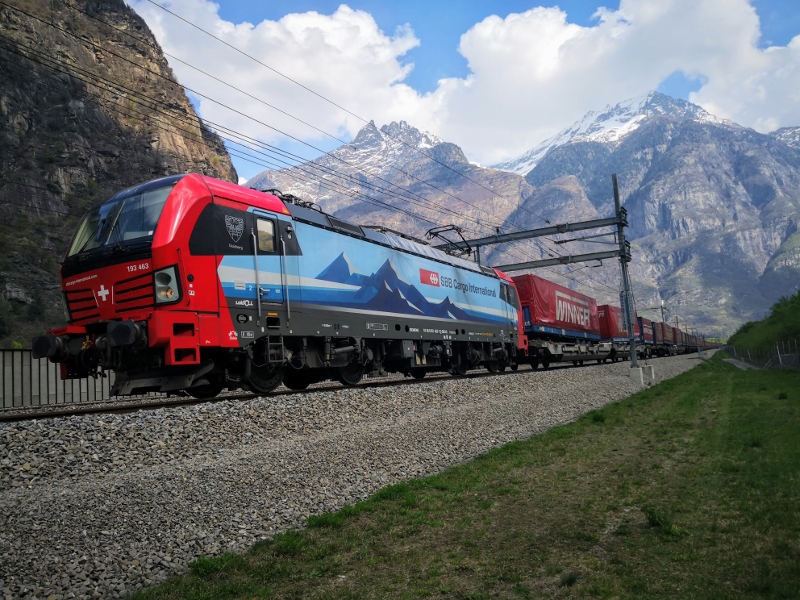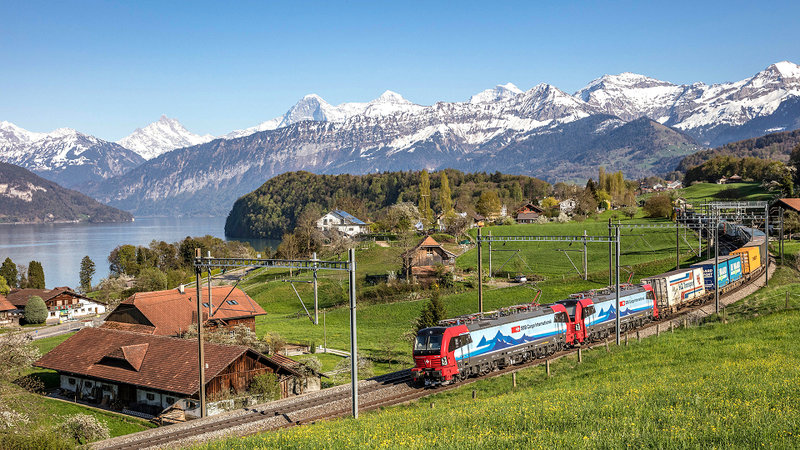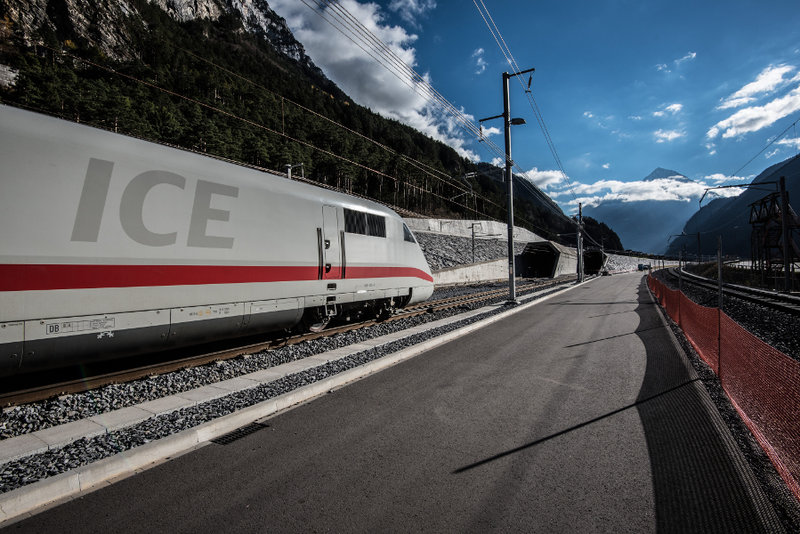We had to find the right construction methods and tunnelling methods
The three base tunnels: Lötschberg, Gotthard and Ceneri
The core elements of NRLA are the three new base tunnels: Lötschberg, Gotthard and Ceneri. These tunnels go straight through the Alps, far lower down than the old road and rail tunnels, meaning that trains no longer have to climb steep gradients when travelling through the world-famous mountain range.
At the time of writing, Gotthard Base Tunnel is the world’s longest and deepest rail tunnel. It measures approximately 57km, took 17 years to construct and opened in 2016. It also required additional support tunnels, passages and shafts that totalled 151km in length. In addition, the sheer mass of rock from the mountains above intensified the rock stresses below.
“We had up to 2,300m overburden and this creates far higher stresses, which can lead to rock burst phenomena or squeezing,” explains Heinz Ehrbar, who was the chief construction officer of Gotthard Base Tunnel. “We had to find the right construction methods and tunnelling methods. And I think we were very lucky that in each of the sections, we had the right tunnelling method - mechanical or conventional.

Gotthard Base Tunnel took 17 years to complete and is the longest and deepest rail tunnel in the world. Image: © AlpTransit Gotthard Ltd.
“For instance, this zoning in the central part of Gotthard – the famous intermediate section – we knew that we had to expect squeezing rock masses, the formation of up to 70cm-80cm convergences. And we had to develop a special construction method to deal with such big deformations.”
Lötschberg was the first NRLA base tunnel to be completed in 2007, with construction taking just under eight years. However, its capacity was lessened because 21km of the tunnel was left single track. The second bore works were not completed due to escalating costs of the wider NRLA project, with Gotthard Base Tunnel given priority. A contract has since been awarded for the doubling of Lötschberg’s single-track section and works are scheduled to be finished by 2028.
At 15.4km long, Ceneri is the shortest of the three NRLA tunnels and the furthest south. Works began in 2006 and it is due to open this December. Its north end is Camorino in Bellinzona, while the south portal is at Vezia, close to Lugano. As with Gotthard, the tunnel consists of two single tracks in each direction.
Tunnelling and excavation
For Gotthard Base Tunnel, an astonishing 25 million tonnes of rock was excavated. For context, this would be enough to build at least five ancient Egyptian pyramids. As much of this material as possible was repurposed for use in the NRLA’s cement and gravel.
Full-face excavation was one of the methods used, which is not a common technique. Special measures were also required to handle squeezing rocks and deformations.
“In the most difficult ground conditions, we took the decision to make a full-face excavation, but then [followed this] with the immediate closure of the support ring with steel rigs,” adds Ehrbar. “And we needed face anchors to stabilise this squeezing face. And finally, we put in the shotcrete. But the shotcrete was placed in only after the deformations occurred and we had deformations up to 70cm.”

Gotthard Base Tunnel required the excavation of approximately 25 million tonnes of rock. Image: © AlpTransit Gotthard Ltd.
Had the deformations not been dealt with, it could have risked the tunnel structure fracturing or even collapsing in the future and may have required significant reconstruction works.
Another challenge with the base tunnels is that parts of the Swiss Alps contain large sections of granite, which proved tough work even for the heavy-duty tunnel boring machines (TBMs).
“When the granite became very hard then we had far more maintenance for TBMs, and this was the challenge,” says Ehrbar. “The discs had to be changed far more often and also the cutter-head had to be welded with protection plates and such things. These were the measures we had to take. But with excavation methods resulting from the tendering process, we always had the right method.”
Had the deformations not been dealt with, it could have risked the tunnel structure fracturing or even collapsing
The greater height and width of the tunnels enables the transportation of higher containers
Advantages for the Swiss supply chain
NRLA will be an integral part of the future of the Rhine-Alpine corridor, connecting seaports in Rotterdam in the Netherlands and Belgium’s Zeebrugge with Genoa in Italy, as well as links to the rest of Europe.
A big advantage for Swiss freight is the longer trains, which will be up to 750m long (around 200m longer than before). However, one drawback is consistency in train length regulations throughout the other countries that freight will pass through.
Although the Netherlands and Belgium are nearly ready to start running the 750m freight trains, Germany currently has a limit of 690m and this is not due to change until 2030. In the meantime, the 750m trains on the Rhine-Alpine corridor will be limited to running south of Basel.

An estimated 30% increase in Swiss freight capacity can be achieved by a combination of the NRLA and longer trains. Image: SBB Cargo International.
Another main benefit of the NRLA is that freight trains are able to run with greater tonnages. For freight trains travelling 1,151m up to the old Gotthard Rail Tunnel, there was a maximum weight restriction of 1,500t. In contrast, rail freight weighing up to 3,600t will be possible through NRLA tunnels.
“That's a main achievement because we can run trains through Switzerland with 2,000t-plus with resources for flat trajectory, which wasn't possible before,” says Ulla Kempf, head of resource planning at SBB Cargo International. “We gain up to 30% in capacity on the train. That’s quite substantial.”
Alongside this, the greater height and width of the tunnels enables the transportation of higher containers, known as the P400 Standard.
“With the P400, we can run high-cube containers and also trailers, in addition to the 40ft / 20ft standard container,” adds Kempf. “We expect because of the P400 Standard – which is completely achieved in all countries on the Rhine-Alpine corridor running through the Alps – that we have a 50% bigger market possibility because we can now run the trailers. That’s where we see the big potential for the shift from road to rail.”

The P400 profile allows containers from the back of lorries to be more easily be transported on rail with semi-trailers, removing HGVs from the small alpine roads. Image: SBB Cargo International.
This extra height also means that lorries can simply have their trailers removed and loaded onto semi-trailers for transportation by rail.
“There are already lorry trailers that run through the Alps on trains, but those need special wagons,” explains Kempf. “These are heavily expensive due to their small wheels and there are a lot of extra conditions for operations. So with the new profile, we can use them on standard wagons. The market potential is estimated at about 400,000 trailers a year."
Competition and cooperation
Although rail is increasingly seen as a more appealing means of large-scale freight transportation, it cannot fulfil all the requirements of road - especially for ‘last mile’ and deliveries. Cooperation will continue to be needed alongside the competition.
“It's not an ‘either/or’,” Kempf says. “We don't have either rail or road; we have a combination and hopefully a very ecologically and economically good combination of the two. It has been calculated that with the effects of the NRLA, the subsidies – that are foreseen by the Swiss Government in order to make rail competitive with road – can be reduced.

High-speed passenger services will cut the travel time between European cities. Image: © AlpTransit Gotthard Ltd.
“But then at the same time, once the oil price drops and diesel prices drop, we're suddenly having a different conversation. That's always in flow, because each side is trying to be more productive. So we always have a competition between road and rail.
“I think we are very close now, at least on this axis. The full effect of the NRLA is expected in 2030. However, we never know what to expect in between.”
The full effect of the NRLA is expected in 2030